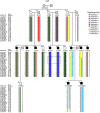Pedigree-Based Gene Mapping Supports Previous Loci and Reveals Novel Suggestive Loci in Specific Language Impairment
- PMID: 33186502
- PMCID: PMC8608229
- DOI: 10.1044/2020_JSLHR-20-00102
Pedigree-Based Gene Mapping Supports Previous Loci and Reveals Novel Suggestive Loci in Specific Language Impairment
Abstract
Purpose Specific language impairment (SLI) is characterized by a delay in language acquisition despite a lack of other developmental delays or hearing loss. Genetics of SLI is poorly understood. The purpose of this study is to identify SLI genetic loci through family-based linkage mapping. Method We performed genome-wide parametric linkage analysis in six families segregating with SLI. An age-appropriate standardized omnibus language measure was used to categorically define the SLI phenotype. Results A suggestive linkage region replicated a previous region of interest with the highest logarithm of odds (LOD) score of 2.40 at 14q11.2-q13.3 in Family 489. A paternal parent-of-origin effect associated with SLI and language phenotypes on a nonsynonymous single nucleotide polymorphism (SNP) in NOP9 (14q12) was reported previously. Linkage analysis identified a new SLI locus at 15q24.3-25.3 with the highest parametric LOD score of 3.06 in Family 315 under a recessive mode of inheritance. Suggestive evidence of linkage was also revealed at 4q31.23-q35.2 in Family 300, with the highest LOD score of 2.41. Genetic linkage was not identified in the other three families included in parametric linkage analysis. Conclusions These results are the first to report genome-wide suggestive linkage with a total language standard score on an age-appropriate omnibus language measure across a wide age range. Our findings confirm previous reports of a language-associated locus on chromosome 14q, report new SLI loci, and validate the pedigree-based parametric linkage analysis approach to mapping genes for SLI. Supplemental Material https://doi.org/10.23641/asha.13203218.
Figures


Similar articles
-
A genome-wide analysis in consanguineous families reveals new chromosomal loci in specific language impairment (SLI).Eur J Hum Genet. 2019 Aug;27(8):1274-1285. doi: 10.1038/s41431-019-0398-1. Epub 2019 Apr 11. Eur J Hum Genet. 2019. PMID: 30976110 Free PMC article.
-
A genomewide scan identifies two novel loci involved in specific language impairment.Am J Hum Genet. 2002 Feb;70(2):384-98. doi: 10.1086/338649. Epub 2002 Jan 4. Am J Hum Genet. 2002. PMID: 11791209 Free PMC article.
-
Highly significant linkage to the SLI1 locus in an expanded sample of individuals affected by specific language impairment.Am J Hum Genet. 2004 Jun;74(6):1225-38. doi: 10.1086/421529. Epub 2004 May 3. Am J Hum Genet. 2004. PMID: 15133743 Free PMC article.
-
Genome-Wide Studies of Specific Language Impairment.Curr Behav Neurosci Rep. 2014;1(4):242-250. doi: 10.1007/s40473-014-0024-z. Curr Behav Neurosci Rep. 2014. PMID: 25411653 Free PMC article. Review.
-
Defining the genetic architecture of human developmental language impairment.Life Sci. 2012 Apr 9;90(13-14):469-75. doi: 10.1016/j.lfs.2012.01.016. Epub 2012 Feb 17. Life Sci. 2012. PMID: 22365959 Free PMC article. Review.
Cited by
-
Genome-wide analysis of runs of homozygosity in Pakistani controls with no history of speech or language-related developmental phenotypes.Ann Hum Biol. 2023 Feb;50(1):100-107. doi: 10.1080/03014460.2023.2180087. Ann Hum Biol. 2023. PMID: 36786444 Free PMC article.
-
Study of rare genetic variants in TM4SF20, NFXL1, CNTNAP2, and ATP2C2 in Pakistani probands and families with language impairment.Meta Gene. 2021 Dec;30:100966. doi: 10.1016/j.mgene.2021.100966. Epub 2021 Aug 27. Meta Gene. 2021. PMID: 34540591 Free PMC article.
-
Family-Based Whole-Exome Analysis of Specific Language Impairment (SLI) Identifies Rare Variants in BUD13, a Component of the Retention and Splicing (RES) Complex.Brain Sci. 2021 Dec 30;12(1):47. doi: 10.3390/brainsci12010047. Brain Sci. 2021. PMID: 35053791 Free PMC article.
-
A rare missense variant in the ATP2C2 gene is associated with language impairment and related measures.Hum Mol Genet. 2021 Jun 9;30(12):1160-1171. doi: 10.1093/hmg/ddab111. Hum Mol Genet. 2021. PMID: 33864365 Free PMC article.
-
Genome-Wide Mapping of Consanguineous Families Confirms Previously Implicated Gene Loci and Suggests New Loci in Specific Language Impairment (SLI).Children (Basel). 2024 Aug 30;11(9):1063. doi: 10.3390/children11091063. Children (Basel). 2024. PMID: 39334596 Free PMC article.
References
-
- Abecasis, G. R. , Cherny, S. S. , Cookson, W. O. , & Cardon, L. R. (2002). Merlin-rapid analysis of dense genetic maps using sparse gene flow trees. Nature Genetics, 30(1), 97–101. https://doi.org/10.1038/ng786 - PubMed
-
- Abreu, P. C. , Greenberg, D. A. , & Hodge, S. E. (1999). Direct power comparisons between simple LOD scores and NPL scores for linkage analysis in complex diseases. The American Journal of Human Genetics, 65(3), 847–857. https://doi.org/10.1086/302536 - PMC - PubMed
-
- Adlof, S. M. , & Hogan, T. P. (2019). If we don't look, we won't see: Measuring language development to inform literacy instruction. Policy Insights from the Behavioral and Brain Sciences, 6(2), 210–217. https://doi.org/10.1177/2372732219839075 - PMC - PubMed
-
- Andres, E. M. , Hafeez, H. , Yousaf, A. , Riazuddin, S. , Rice, M. L. , Basra, M. A. R. , & Raza, M. H. (2019). A genome-wide analysis in consanguineous families reveals new chromosomal loci in specific language impairment (SLI). European Journal of Human Genetics, 27(8), 1274–1285. https://doi.org/10.1038/s41431-019-0398-1 - PMC - PubMed
-
- Bailey-Wilson, J. E. , & Wilson, A. F. (2011). Linkage analysis in the next-generation sequencing era. Human Heredity, 72(4), 228–236. https://doi.org/10.1159/000334381 - PMC - PubMed
Publication types
MeSH terms
Grants and funding
LinkOut - more resources
Full Text Sources

